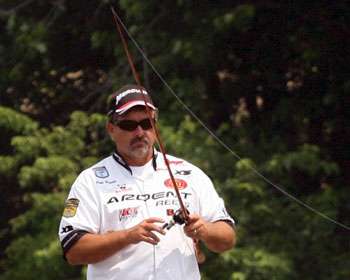
How many times have you awakened the morning after a heavy rain to discover that the lake or river you'd dreamed of spending the day chasing bass on was swollen and muddy? Many times, the average angler will give up and head back home as opposed to trying to make the most of the murky situation.
If you're an Elite Series pro, going back to bed isn't an option. As Pete Ponds explains, muddy water is another challenge that competitors at the highest level of the sport have to contend with, especially early in the season. "Early in the year, particularly on river systems, you're going to want to find the clearest water possible," the veteran Mississippi angler says."
On a river, that's usually going to be in one of the oxbow lakes." On the rivers and lakes of Pete's native Mississippi, the term "clear" may have different meaning to different people. As he points out, your bait selection must be based on vibration, or water displacement, in order to elicit a reaction.
"Once you're into some clearer water, it still might have some pretty good color to it," he says. "Because of that, you're going to want to use a bait that throws off a lot of vibration." By focusing on the shallows, Pete explains that you're more likely to find bass that will react. "I think that the fish are almost easier to find when it's muddy because they're going to be super shallow," he reveals. "That eliminates probably 70 percent of the lake or river that you're fishing."
Later in the season, as the weather trends begin to stabilize, lakes and rivers clear up and bass become more mobile. As a result, Ponds explains that he moves with the fish. "I tend to gravitate towards the mouths of creeks and oxbows," he points out. "However, if you're fishing during the spawning season, you're obviously going to want to go to the very back end of the creek or oxbow that you're fishing."
When the water is high and muddy, Ponds is most likely to target visible cover. "When the water is really stained, I focus on anything that's in the water," he explains. "Brush, laydowns and things like that make great ambush points, and they're generally in shallower water where the bass will be holding." How "shallow" is shallow, you might be asking?
"Shallow can be a relative term," Ponds answers. "Take the Mississippi River in Iowa as an example. There, shallow to me means 8 or 9 inches, whereas on a lake where the average depth is better than 20 feet, shallow might mean 3 feet." Ponds points out that it's imperative that anglers pay close attention to the water level, and adjust accordingly. "If the water level is falling, you need to fish in front (on the deeper side) of the structure that they were on (previously)," he explains. "Bass will usually follow the water up as it rises, and follow it out as it falls.
An exception to that would be if it's during the spawn." Besides fishing with lures that displace water or send out vibration, Ponds explains that anglers fishing muddy waters also want baits, including crankbaits and spinnerbaits, that will deflect off cover, or cause a commotion in the water. "You have to be thinking that the fish can't really see, so they have to go by detecting movement from their lateral line," he points out.
"When the water is muddy, they tend to feel it rather than see it. Also, scent is a big factor when you're fishing muddy water. I think those two things can play a huge role in whether you're going to catch them or not when the water's muddy."




